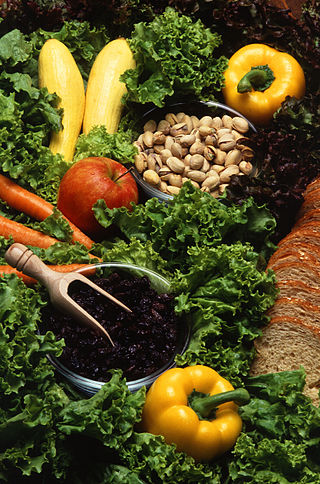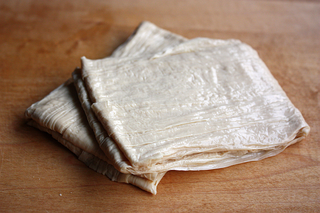
Vegetarian cuisine is based on food that meets vegetarian standards by not including meat and animal tissue products.

The soybean,soy bean,or soya bean is a species of legume native to East Asia,widely grown for its edible bean,which has numerous uses.

Tempeh or tempe is a traditional Indonesian food made from fermented soybeans. It is made by a natural culturing and controlled fermentation process that binds soybeans into a cake form. A fungus,Rhizopus oligosporus or Rhizopus oryzae,is used in the fermentation process and is also known as tempeh starter.

Nattō,spelled as natto in standard English language use,is a traditional Japanese food made from whole soybeans that have been fermented with Bacillus subtilis var. natto. It is often served as a breakfast food with rice. It is served with karashi mustard,soy or tare sauce,and sometimes Japanese bunching onion. Within Japan,nattō is most popular in the eastern regions,including Kantō,Tōhoku,and Hokkaido.

Soy milk,also known as soya milk or soymilk,is a plant-based drink produced by soaking and grinding soybeans,boiling the mixture,and filtering out remaining particulates. It is a stable emulsion of oil,water,and protein. Its original form is an intermediate product of the manufacture of tofu. Originating in China,it became a common beverage in Europe and North America in the latter half of the 20th century,especially as production techniques were developed to give it a taste and consistency more closely resembling that of dairy milk. Soy milk may be used as a substitute for dairy milk by individuals who are vegan or lactose intolerant.

Tofu skin,Yuba,beancurd skin,beancurd sheet,or beancurd robes is a food product made from soybeans. During the boiling of soy milk,in an open shallow pan,a film or skin composed primarily of a soy protein-lipid complex forms on the liquid surface. The films are collected and dried into yellowish sheets known as tofu skin. Since tofu skin is not produced using a coagulant,it is not technically a proper tofu;however,it does have similar texture and flavor to some tofu products.

Fermented tofu is a Chinese condiment consisting of a form of processed,preserved tofu used in East Asian cuisine. The ingredients typically are soybeans,salt,rice wine and sesame oil or vinegar. In mainland China the product is often freshly distributed. In overseas Chinese communities living in Southeast Asia,commercially packaged versions are often sold in jars containing blocks 2- to 4-cm square by 1 to 2 cm thick soaked in brine with select flavorings.

A milk substitute is any substance that resembles milk and can be used in the same ways as milk. Such substances may be variously known as non-dairy beverage,nut milk,grain milk,legume milk,mock milk and alternative milk.

Rhizopus oligosporus is a fungus of the family Mucoraceae and is a widely used starter culture for the production of tempeh at home and industrially. As the mold grows it produces fluffy,white mycelia,binding the beans together to create an edible "cake" of partly catabolized soybeans. The domestication of the microbe is thought to have occurred in Indonesia several centuries ago.

Cheonggukjang is a traditional Korean food made by fermenting soybeans. It contains whole,as well as ground soybeans.

In food processing,fermentation is the conversion of carbohydrates to alcohol or organic acids using microorganisms—yeasts or bacteria—under anaerobic (oxygen-free) conditions. Fermentation usually implies that the action of microorganisms is desired. The science of fermentation is known as zymology or zymurgy.

Oncom is one of the traditional staple foods of Sundanese cuisine of Indonesia. There are two kinds of oncom:red oncom and black oncom. Oncom is closely related to tempeh;both are foods fermented using mold.

Soy protein is a protein that is isolated from soybean. It is made from soybean meal that has been dehulled and defatted. Dehulled and defatted soybeans are processed into three kinds of high protein commercial products:soy flour,concentrates,and isolates. Soy protein isolate has been used since 1959 in foods for its functional properties.

Tofu is a food prepared by coagulating soy milk and then pressing the resulting curds into solid white blocks of varying softness:silken,soft,firm,extra firm. Tofu is also known as bean curd in English. Beyond these broad textural categories,there are many varieties of tofu. It has a subtle flavor,so it can be used in savory and sweet dishes. It is often seasoned or marinated to suit the dish and its flavors,and due to its spongy texture,it absorbs flavors well. It is a traditional component of East Asian and Southeast Asian cuisines,and has been consumed in China for over 2,000 years. In modern Western cooking,it is most often treated as a meat substitute.

Sundanese cuisine is the cuisine of the Sundanese people of Western Java,and Banten,Indonesia. It is one of the most popular foods in Indonesia. Sundanese food is characterised by its freshness;the famous lalab eaten with sambal and also karedok demonstrate the Sundanese fondness for fresh raw vegetables. Unlike the rich and spicy taste,infused with coconut milk and curry of Minangkabau cuisine,the Sundanese cuisine displays the simple and clear taste;ranged from savoury salty,fresh sourness,mild sweetness,to hot and spicy.

Tauge goreng is an Indonesian savoury vegetarian dish made of stir-fried tauge with slices of tofu,ketupat or lontong rice cake and yellow noodles,served in a spicy oncom-based sauce. Tauge goreng is a specialty of Jakarta and Bogor city,West Java,Indonesia. It is usually sold as street food using pikulan or gerobak (cart) by street vendors. It is a popular street food in Indonesia,especially in Jakarta,and Greater Jakarta areas,including Bogor,Depok,Tangerang and Bekasi.
William Roy Shurtleff also known as Bill Shurtleff is an American researcher and writer about soy foods. Shurtleff and his former wife Akiko Aoyagi have written and published consumer-oriented cookbooks,handbooks for small- and large-scale commercial production,histories,and bibliographies of various soy foods. These books introduced soy foods such as tofu,tempeh,and miso on a wide scale to non-Asian Westerners,and are largely responsible for the establishment of non-Asian soy food manufacturers in the West beginning in the late 1970s. In 1980,Lorna Sass wrote in The New York Times,"The two people most responsible for catapulting tofu from the wok into the frying pan are William Shurtleff and Akiko Aoyagi.”In 1995,Suzanne Hamlin wrote in The New York Times,“At the turn of the century there were two tofu suppliers in the United States. Today there are more than 200 tofu manufacturers...and tofu can be found in nearly every supermarket."




















